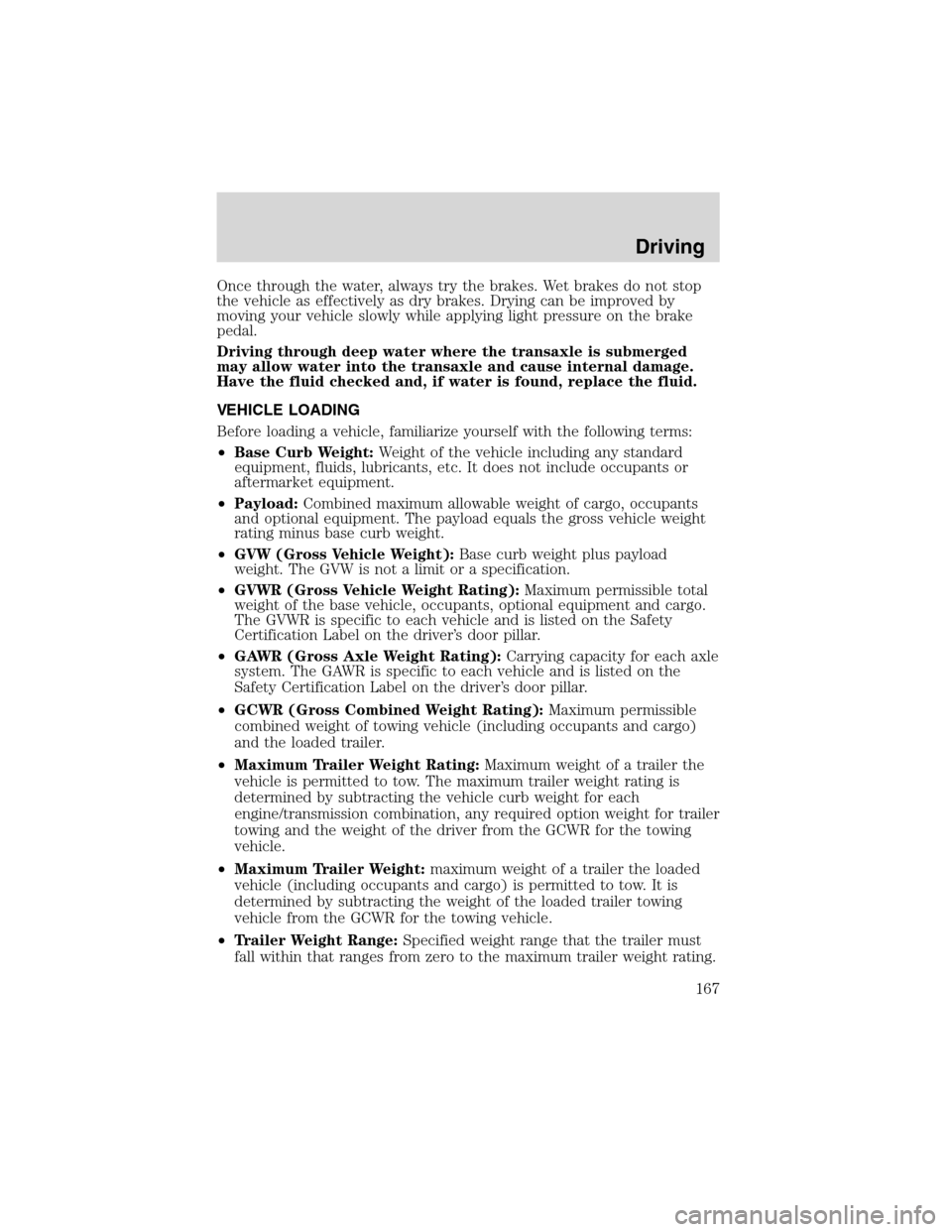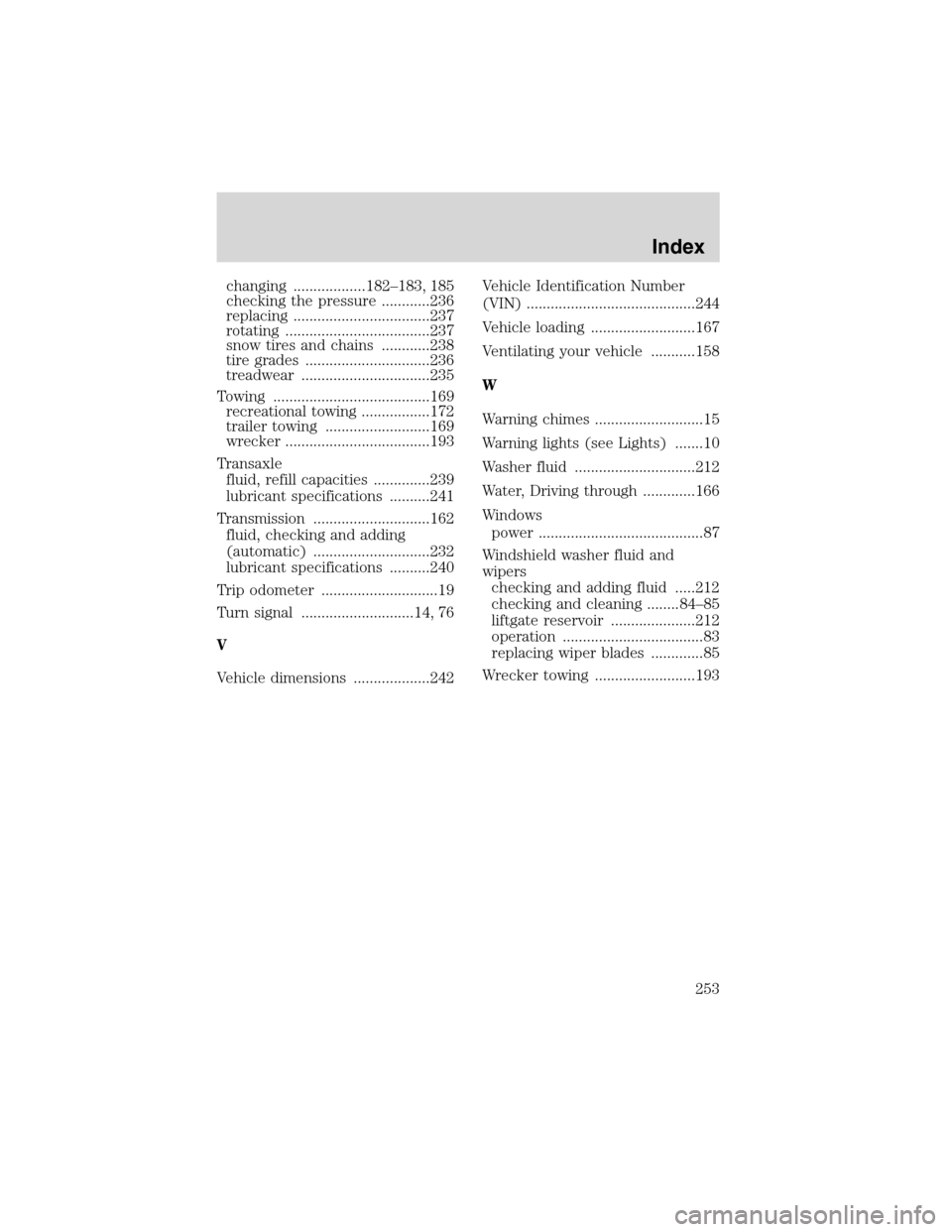check transmission fluid Mercury Villager 2002 Owner's Manuals
[x] Cancel search | Manufacturer: MERCURY, Model Year: 2002, Model line: Villager, Model: Mercury Villager 2002Pages: 256, PDF Size: 1.91 MB
Page 167 of 256

Once through the water, always try the brakes. Wet brakes do not stop
the vehicle as effectively as dry brakes. Drying can be improved by
moving your vehicle slowly while applying light pressure on the brake
pedal.
Driving through deep water where the transaxle is submerged
may allow water into the transaxle and cause internal damage.
Have the fluid checked and, if water is found, replace the fluid.
VEHICLE LOADING
Before loading a vehicle, familiarize yourself with the following terms:
•Base Curb Weight:Weight of the vehicle including any standard
equipment, fluids, lubricants, etc. It does not include occupants or
aftermarket equipment.
•Payload:Combined maximum allowable weight of cargo, occupants
and optional equipment. The payload equals the gross vehicle weight
rating minus base curb weight.
•GVW (Gross Vehicle Weight):Base curb weight plus payload
weight. The GVW is not a limit or a specification.
•GVWR (Gross Vehicle Weight Rating):Maximum permissible total
weight of the base vehicle, occupants, optional equipment and cargo.
The GVWR is specific to each vehicle and is listed on the Safety
Certification Label on the driver’s door pillar.
•GAWR (Gross Axle Weight Rating):Carrying capacity for each axle
system. The GAWR is specific to each vehicle and is listed on the
Safety Certification Label on the driver’s door pillar.
•GCWR (Gross Combined Weight Rating):Maximum permissible
combined weight of towing vehicle (including occupants and cargo)
and the loaded trailer.
•Maximum Trailer Weight Rating:Maximum weight of a trailer the
vehicle is permitted to tow. The maximum trailer weight rating is
determined by subtracting the vehicle curb weight for each
engine/transmission combination, any required option weight for trailer
towing and the weight of the driver from the GCWR for the towing
vehicle.
•Maximum Trailer Weight:maximum weight of a trailer the loaded
vehicle (including occupants and cargo) is permitted to tow. It is
determined by subtracting the weight of the loaded trailer towing
vehicle from the GCWR for the towing vehicle.
•Trailer Weight Range:Specified weight range that the trailer must
fall within that ranges from zero to the maximum trailer weight rating.
Driving
167
Page 232 of 256

2. Visually inspect the fluid level.
3. If necessary, add brake fluid from
a clean un-opened container until
the level reaches MAX. Do not fill
above this line.
4. Use only a DOT 3 brake fluid
certified to meet Ford specification
ESA-M6C25–A. Refer toLubricant
specificationsin this chapter.
Brake fluid is toxic. If brake fluid contacts the eyes, flush eyes
with running water for 15 minutes. Seek medical attention if
irritation persists. If taken internally, drink water and induce vomiting.
Seek medical attention immediately.
If you use a brake fluid that is not DOT 3, you will cause
permanent damage to your brakes.
Do not let the fluid level in the reservoir for the master cylinder
fall below the MIN mark. If master cylinder runs dry, this may
cause the brakes to fail.
TRANSMISSION FLUID
Checking automatic transmission fluid
Refer to your scheduled maintenance guide for scheduled intervals for
fluid checks and changes. Your transaxle does not consume fluid.
However, the fluid level should be checked if the transaxle is not working
properly, i.e., if the transaxle slips or shifts slowly or if you notice some
sign of fluid leakage.
Automatic transmission fluid expands when warmed. To obtain an
accurate fluid check, drive the vehicle until it is warmed up
(approximately 30 km [20 miles]). If your vehicle has been
operated for an extended period at high speeds, in city traffic
during hot weather or pulling a trailer, the vehicle should be
turned off for about 30 minutes to allow fluid to cool before
checking.
MAX
MIN
Maintenance and Specifications
232
Page 233 of 256

1. Drive the vehicle 30 km (20 miles) or until it reaches normal operating
temperature.
2. Park the vehicle on a level surface and engage the parking brake.
3. With the parking brake engaged and your foot on the brake pedal,
start the engine and move the gearshift lever through all of the gear
ranges. Allow sufficient time for each gear to engage.
4. Latch the gearshift lever in P (Park) and leave the engine running.
5. Remove the dipstick, wiping it clean with a clean, dry lint free rag. If
necessary, refer toIdentifying components in the engine compartment
in this chapter for the location of the dipstick.
6. Install the dipstick making sure it is fully seated in the filler tube.
7. Remove the dipstick and inspect the fluid level. The fluid should be in
the designated areas for normal operating temperature.
Low fluid level
Do not drive the vehicle if the fluid
level is at the bottom of the dipstick
and the outside temperatures are
above 10°C (50°F).
Correct fluid level
The transmission fluid should be checked at normal operating
temperatures 66°C-77°C (150°F-170°F) on a level surface. The normal
operating temperature can be reached after approximately 30 km (20
miles) of driving.
The transmission fluid should be in
this range if at normal operating
temperature (66°C-77°C
[150°F-170°F]).
High fluid level
Fluid levels above the safe range
may result in transaxle failure. An
overfill condition of transmission
fluid may cause shift and/or
engagement concerns and/or
possible damage.
High fluid levels can be caused by an overheating condition.
HOT
HOT
HOT
Maintenance and Specifications
233
Page 249 of 256

in front seat ............................146
in rear seat ......................146, 148
tether anchorage hardware ...150
Cleaning your vehicle
engine compartment ..............204
exterior ....................................207
instrument panel ....................206
interior .....................................207
plastic parts ............................205
washing ....................................203
waxing .....................................203
wheels ......................................204
wiper blades ............................206
woodtone trim ........................205
Climate control (see Air
conditioning or Heating) ......58, 63
Clock ................................24, 33, 44
Console ......................................103
overhead ....................................86
Controls
power seat ...............................117
steering column ........................94
Coolant
checking and adding ..............217
refill capacities ................220, 239
specifications ..................240–241
Cruise control (see Speed
control) ........................................90
Customer Assistance ................173
Ford accessories for your
vehicle .....................................208
Ford Extended Service
Plan ..........................................196
Getting assistance outside the
U.S. and Canada .....................200
Getting roadside assistance ...173
Getting the service you
need .........................................194
Ordering additional owner’s
literature .................................201The Dispute Settlement
Board .......................................197
Utilizing the
Mediation/Arbitration
Program ...................................200
D
Defrost
rear window ..............................72
Dipstick
automatic transmission
fluid ..........................................232
engine oil .................................212
Doors
door ajar warning .....................14
lubricant specifications ..........240
Driving under special
conditions
through water .........................166
E
Emergencies, roadside
jump-starting ..........................188
Emission control system ..........229
Engine ................................241–242
check engine/service engine
soon light ..................................10
cleaning ...................................204
coolant .....................................217
idle speed control ...................215
lubrication
specifications ..................240–241
refill capacities ........................239
service points ..........................211
starting after a collision .........174
Engine oil ..................................212
checking and adding ..............212
dipstick ....................................212
Index
249
Page 253 of 256

changing ..................182–183, 185
checking the pressure ............236
replacing ..................................237
rotating ....................................237
snow tires and chains ............238
tire grades ...............................236
treadwear ................................235
Towing .......................................169
recreational towing .................172
trailer towing ..........................169
wrecker ....................................193
Transaxle
fluid, refill capacities ..............239
lubricant specifications ..........241
Transmission .............................162
fluid, checking and adding
(automatic) .............................232
lubricant specifications ..........240
Trip odometer .............................19
Turn signal ............................14, 76
V
Vehicle dimensions ...................242Vehicle Identification Number
(VIN) ..........................................244
Vehicle loading ..........................167
Ventilating your vehicle ...........158
W
Warning chimes ...........................15
Warning lights (see Lights) .......10
Washer fluid ..............................212
Water, Driving through .............166
Windows
power .........................................87
Windshield washer fluid and
wipers
checking and adding fluid .....212
checking and cleaning ........84–85
liftgate reservoir .....................212
operation ...................................83
replacing wiper blades .............85
Wrecker towing .........................193
Index
253